Effortless Quick Pickled Vegetables: Your Guide to Flavorful Refrigerator Pickles
Quick Pickled Vegetables are a culinary revelation for anyone looking to add a burst of vibrant flavor and a satisfying crunch to their meals without a significant time commitment. These versatile refrigerator pickles are an incredibly easy way to preserve fresh vegetables, transforming them into tangy, irresistible additions that elevate everything from simple salads and hearty rice bowls to savory tacos and gourmet sandwiches. Imagine having a jar of bright, zesty vegetables ready to liven up any dish at a moment’s notice!
Unlike traditional canning methods that require specialized equipment and a precise process, quick pickling offers a fast, accessible, and highly customizable alternative. In just minutes of active prep time, you can create a batch of these flavorful veggies that will last for up to two weeks in your refrigerator. This guide will walk you through everything you need to know, from selecting the best vegetables to mastering your customizable brine, ensuring you can enjoy delicious, homemade pickled goodness whenever the craving strikes.
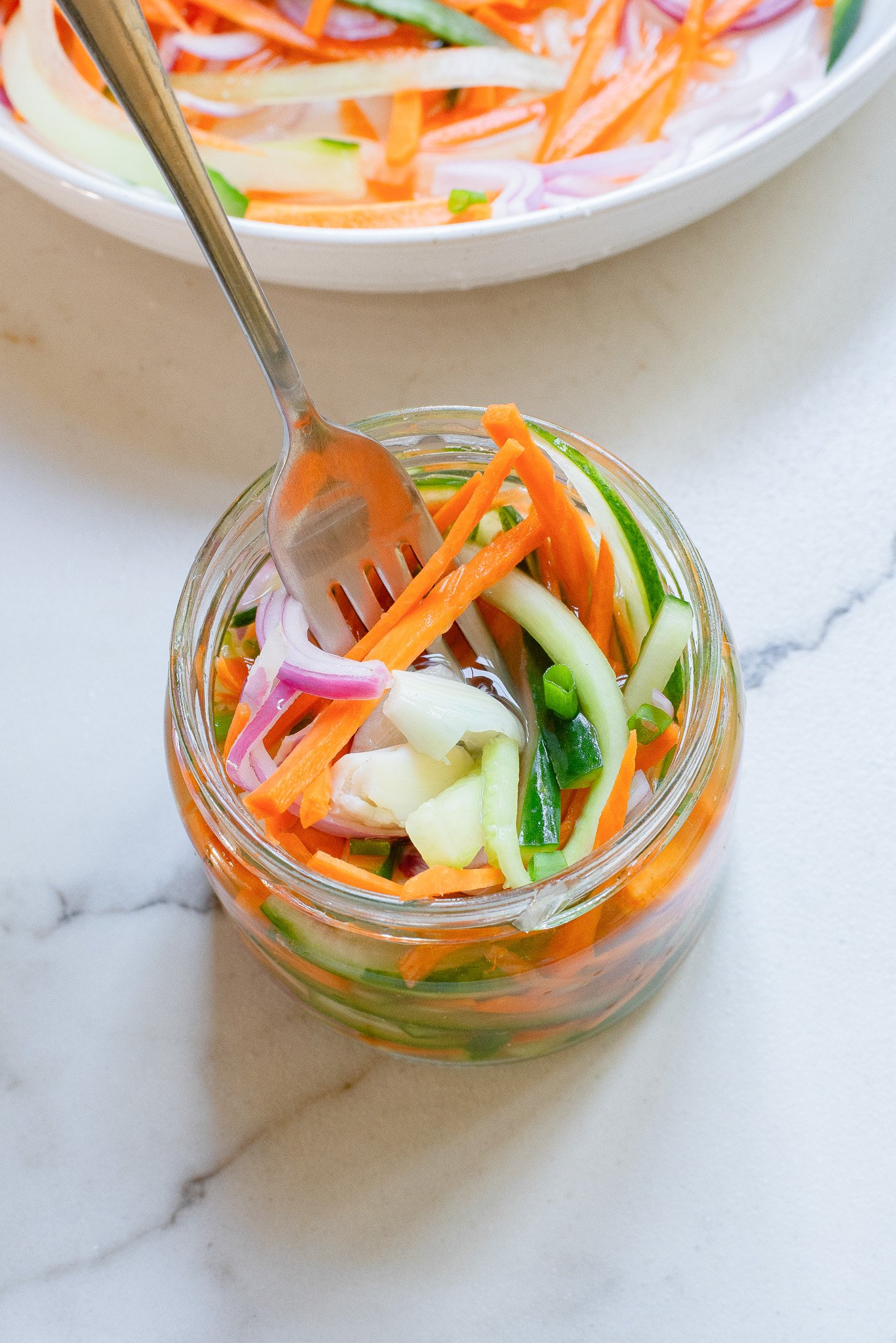
My personal love affair with pickles runs deep, extending to virtually any pickled vegetable I can get my hands on. Recently, I stumbled upon a company selling deliciously spicy pickled carrots, and it was an instant infatuation! That experience sparked a realization: making homemade pickled vegetables is incredibly simple and doesn’t require the complicated process of traditional canning. Today’s Quick Pickled Vegetables recipe embodies that simplicity, offering a fast and customizable method for preserving a wide array of fresh veggies, spices, and herbs.
This recipe reminds me of my popular Easy Curtido Recipe, a Salvadoran pickled cabbage slaw that’s equally vibrant and easy to make. You might also enjoy my Quick Pickled Red Onions, which are a fantastic topping for so many dishes.
I find this recipe particularly useful when I have a bounty of vegetables from my garden, a haul from the farmer’s market, or simply a collection of fresh produce in my fridge that needs to be used before it spoils. It’s a fantastic way to prevent food waste while creating something delicious.
What Are Quick Pickled Vegetables?
Many people wonder about the distinction between quick pickling and traditional canning. The answer lies in both the process and the shelf life. Quick pickling, also commonly known as refrigerator pickling or cold pickling, is a straightforward and rapid method of preserving vegetables. It involves immersing vegetables in a simple vinegar-based brine solution, then storing them in the refrigerator. Crucially, this method does not require the extensive heat processing, sterilization, and airtight sealing associated with traditional canning or fermentation processes.
Traditional canning aims for long-term, shelf-stable preservation, often for months or even years, by creating a vacuum seal that prevents spoilage. Quick pickling, on the other hand, prioritizes speed and convenience. The vinegar-based brine rapidly infuses the vegetables with a tangy, bright, and typically crisp flavor and texture. Because there’s no heat processing to create a sterile, oxygen-free environment for extended storage, quick pickled vegetables must always be stored in the refrigerator and are best enjoyed within about two weeks.
This “quick” approach makes them perfect for everyday use, allowing you to whip up a batch with minimal effort and enjoy their fresh, zesty taste in a relatively short amount of time, usually after just a few hours or overnight for optimal flavor development.
For more delicious vegetable-focused recipes, you might also like these Balsamic Roasted Mushrooms, my Easy Bok Choy Recipe, a flavorful Bok Choy Stir Fry, or these sweet and savory Honey Balsamic Roasted Carrots.
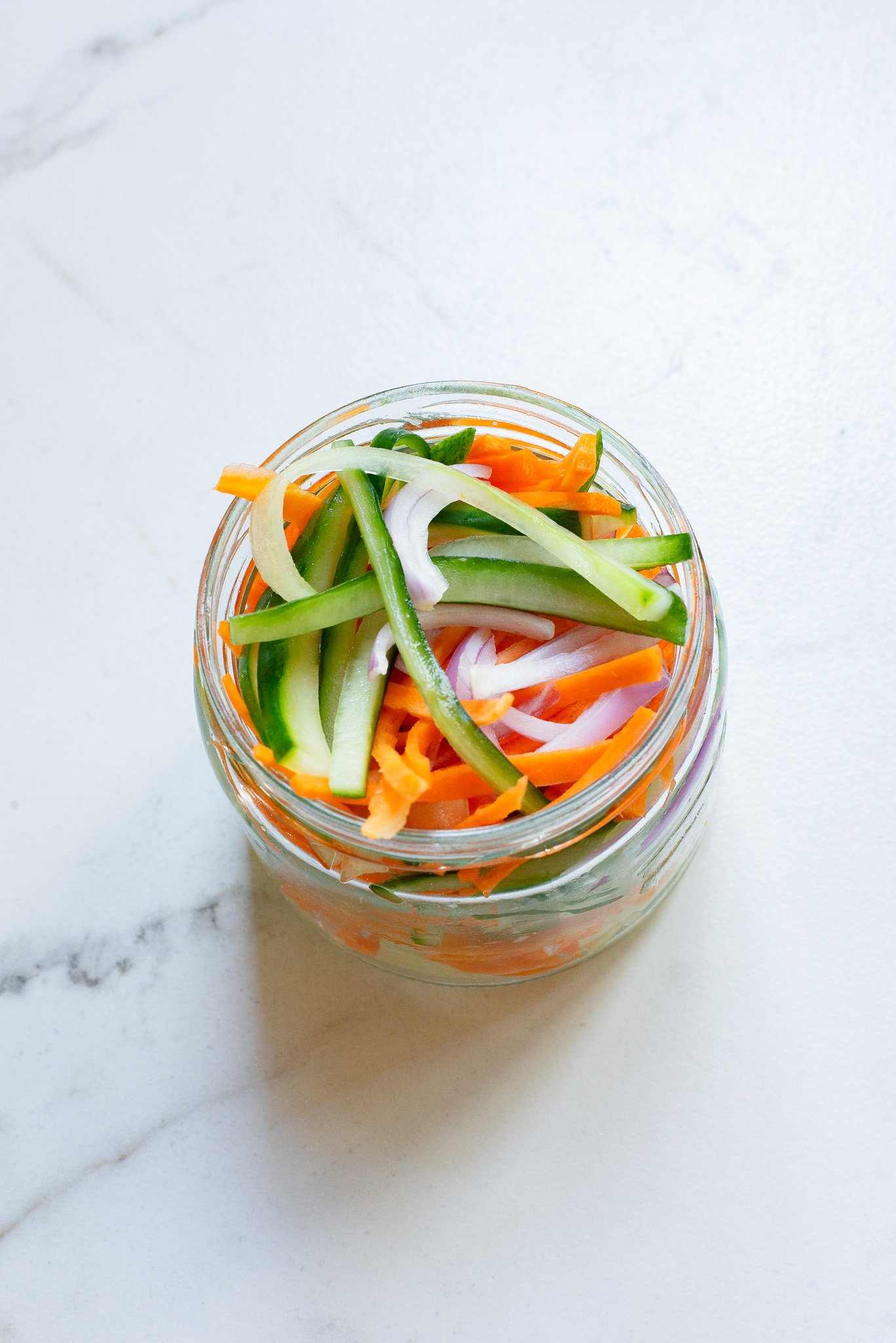
As mentioned, the primary distinction between quick pickling and traditional methods lies in the preservation process. Quick pickling immerses vegetables in a vinegar-based brine and stores them in the refrigerator, allowing them to develop a tangy flavor and crisp texture relatively quickly. There’s no heat processing to create an airtight seal for long-term preservation, which means these delightful veggies are for immediate to short-term enjoyment.
For the best flavor and safety, always store your quick pickled vegetables in the fridge, and I highly recommend consuming them within two weeks. Their peak freshness and crunch are enjoyed within this timeframe.
We absolutely love incorporating quick pickled vegetables into a variety of dishes. They serve as a fantastic tangy element on antipasto platters or charcuterie boards, adding a bright contrast to cheeses and meats. They’re also superb layered into salads, tucked into burgers, hot dogs, and wraps, or piled high on tacos and burritos. And, let’s be honest, sometimes the best way to enjoy them is straight out of the jar as a refreshing and zesty snack!
Why You’ll Love Making Quick Pickled Vegetables
There are countless reasons to fall in love with homemade quick pickled vegetables. They offer a simple solution for meal prepping, reducing food waste, and infusing your everyday dishes with exciting new flavors. Here’s why this recipe will become a staple in your kitchen:
- Elevate Your Dishes with Incredible Flavor: Quick pickled vegetables are a game-changer for adding a layer of tangy, acidic flavor to virtually any meal. Whether it’s a simple rice bowl, a stack of tacos, a hearty wrap, or an elaborate sandwich, their zesty kick brightens and balances the entire dish. You can even tailor the type of vegetables you pickle to complement specific cuisines. For example, bell peppers, red onions, and jalapeños are perfect for Mexican-inspired dishes, while carrots and cucumbers work wonderfully in Asian-style bowls.
- Remarkably Quick and Easy to Make: Forget the lengthy, often intimidating process of traditional canning. This recipe focuses on quick pickling, meaning it’s incredibly fast and straightforward. While the vegetables benefit from sitting in the fridge overnight to fully absorb the delightful brine flavors, you can technically start enjoying them just a few hours after preparing the jar. This speed and ease make them an ideal last-minute addition to your culinary repertoire.
- An Eco-Friendly Solution for Leftover Veggies: One of the most satisfying aspects of quick pickling is its ability to help you use up surplus produce. Whether you’ve harvested an abundance from your garden, brought home too many goodies from the farmers market, or simply have fresh vegetables nearing their prime in your refrigerator, this recipe offers a delicious solution. Instead of letting them go to waste, you can transform them into a flavorful condiment that extends their shelf life and enhances future meals. It’s a smart way to reduce food waste and save money!
- Unleash Your Culinary Creativity: Quick pickling is an art form that encourages experimentation. You’re not limited to a rigid set of ingredients or flavors. From the choice of vegetables to the blend of spices and herbs, almost every element can be customized. This flexibility means you can create unique flavor profiles that perfectly match your palate or the specific dish you’re preparing.
- A Healthier Alternative: By making your own quick pickled vegetables, you control the ingredients. You can reduce sugar and salt content compared to many store-bought options, and you avoid artificial preservatives. Plus, pickling can help retain some of the nutritional value of your fresh vegetables, offering a tasty way to boost your daily veggie intake.
Essential Recipe Ingredients
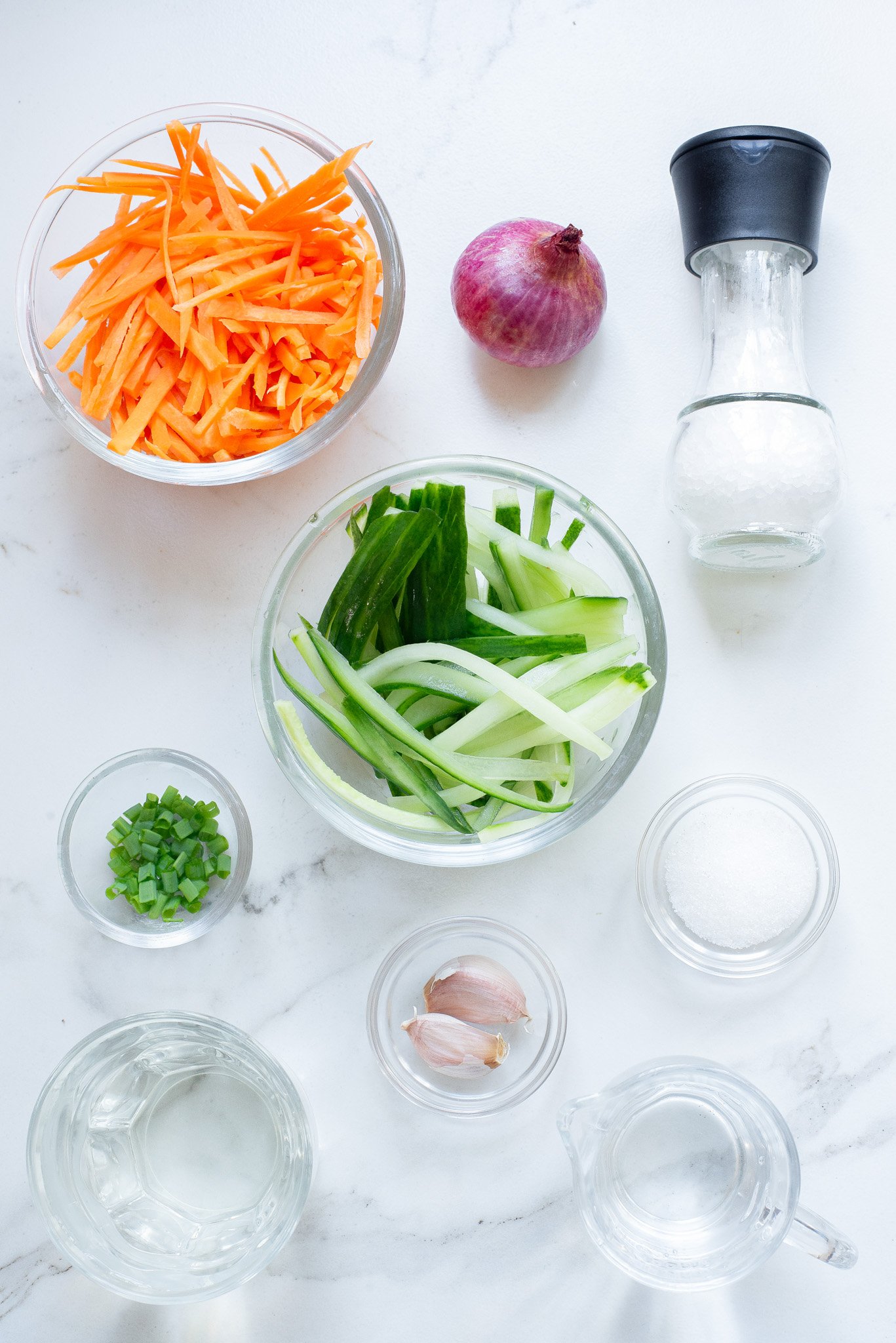
You’ll adore how simple this recipe is, relying on basic ingredients that create an incredibly flavorful pickling brine. This has quickly become one of my go-to recipes!
- Fresh Vegetables: For this particular recipe, we’ll be using crisp carrots, refreshing cucumber, and pungent red onion. These three create a fantastic textural and flavor combination. Remember, the beauty of quick pickling is its flexibility; you can truly use any vegetables you have on hand, adapting them to your taste and what’s in season.
- White Vinegar: The star of the pickling liquid! White vinegar provides the essential acidity that preserves the vegetables and gives them their characteristic tangy flavor. Its clean, sharp profile is perfect for allowing the vegetable and spice flavors to shine.
- Garlic Cloves: Fresh garlic cloves are crucial for imparting a robust, aromatic depth to your pickled veggies. Crushed or thinly sliced, they release their pungent oils into the brine, enhancing the overall flavor.
- Water: Used to dilute the vinegar, creating a balanced brine that’s not overly acidic.
- Granulated Sugar: A touch of sugar helps to balance the sharp acidity of the vinegar, adding a subtle sweetness that rounds out the flavor profile and enhances the vegetables’ natural taste. You can adjust the amount to your preference.
- Sea Salt: Essential for both flavor and preservation. Sea salt helps draw out moisture from the vegetables, contributing to their crisp texture and preventing spoilage.
- Whole Spices (Optional, but Recommended): For the most vibrant and authentic flavors, I highly recommend using whole spices. This recipe calls for whole peppercorns, coriander seeds, and mustard seeds. These spices infuse the brine with complex, warm, and slightly earthy notes that elevate the pickles beyond the ordinary.
Customizing Your Quick Pickled Vegetables: Endless Possibilities
The beauty of quick pickling lies in its incredible adaptability. You can easily modify the ingredients to suit your personal preferences, the vegetables you have on hand, or the cuisine you’re serving them with. Don’t be afraid to get creative and make these pickles uniquely yours!
- Experiment with Spices and Herbs: This is where you can truly make your quick pickled vegetables shine. Spices are a fantastic way to introduce a variety of flavor dimensions. Beyond the classic peppercorns, coriander, and mustard seeds, consider trying:
- Warm & Earthy: Fennel seeds, juniper berries, anise seed, cumin seeds, allspice, or whole cloves.
- Aromatic & Fresh: Dill seed.
- For a Kick: Crushed red pepper flakes, either a pinch for subtle warmth or more for a fiery bite.
- Incorporate Fresh Herbs: Fresh herbs add a wonderful layer of complexity and aroma. A few sprigs or leaves can transform your pickles. Excellent choices include: dill (a classic!), parsley, oregano, basil, bay leaves, chives, rosemary, or sage. Think about the flavor profile you want – dill for traditional, basil for Italian-inspired, or bay leaves for a subtle depth.
- Add a Touch of Citrus: Citrus zest and juice can bring a lovely brightness, tang, and even a hint of sweetness to your brine. Try adding a strip of orange, lemon, or lime zest to the jar, or a squeeze of fresh juice to the cooling brine.
- Choose the Right Vinegar: The type of vinegar you use significantly impacts the final flavor. While white vinegar provides a clean, sharp tang, don’t hesitate to explore other options:
- Apple Cider Vinegar: Offers a fruitier, slightly mellower flavor.
- Rice Vinegar: Milder and slightly sweet, perfect for Asian-inspired pickles.
- White Wine Vinegar: A delicate, slightly floral acidity.
- Red Wine Vinegar: Bolder, with a hint of fruitiness, great for heartier vegetables.
Just ensure your chosen vinegar has at least 5% acidity for proper preservation.
- Adjust Sugar and Salt Levels to Your Taste: The amount of sugar and salt in your brine can be easily tweaked. If you prefer a sweeter pickle, add a little more sugar. For a less sweet profile, reduce it. Similarly, you can adjust the salt to your liking. The key is to maintain a balance that complements your vegetables, so taste the brine before pouring it over the veggies!
- Experiment with Sweeteners: While granulated sugar is common, you can also use other sweeteners like honey, maple syrup, or agave nectar for different flavor nuances.
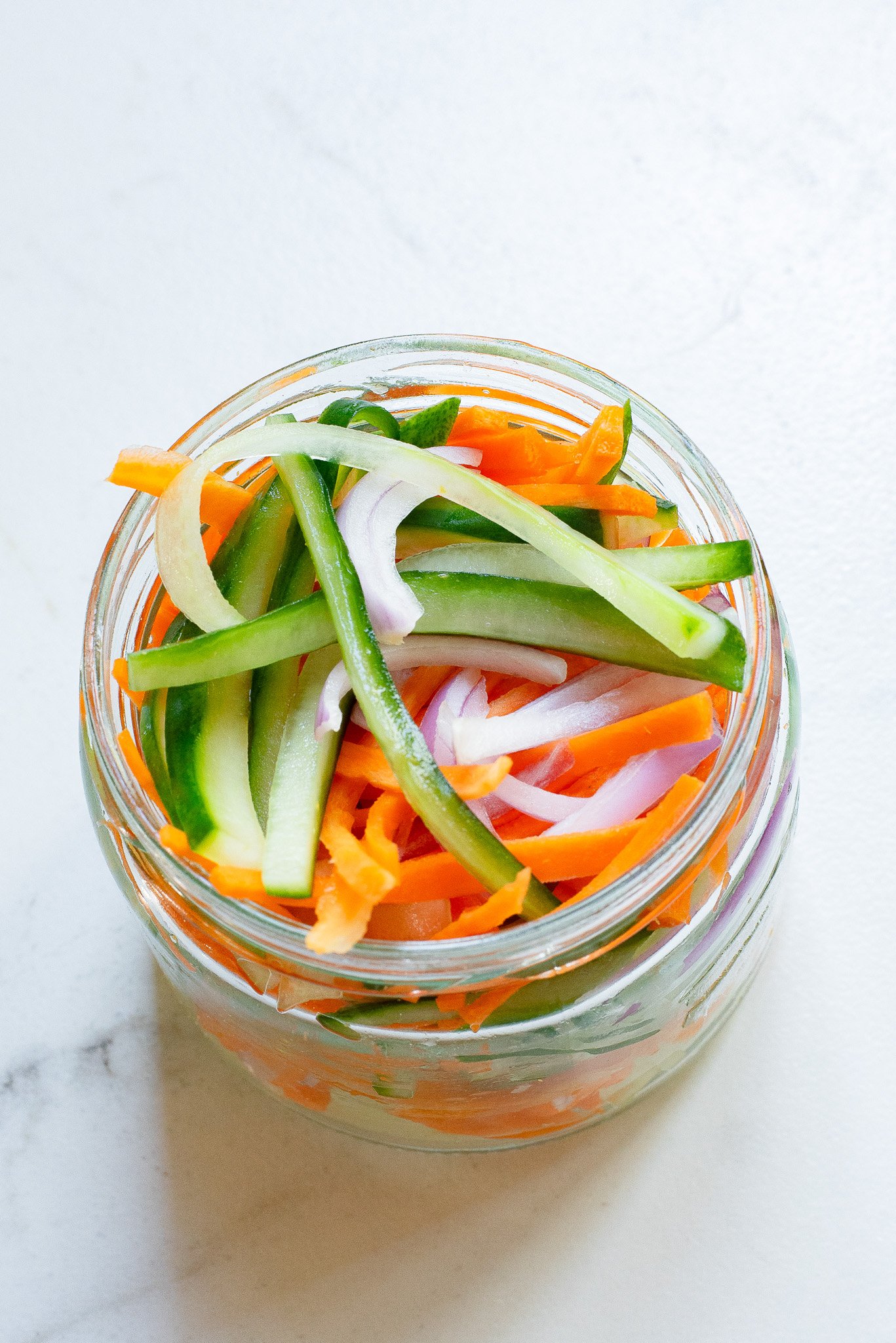
Step-by-Step Guide: How to Make Quick Pickled Vegetables
Making quick pickled vegetables is incredibly simple and takes less than 10 minutes of active preparation. Follow these easy steps to create your own delicious batch:
Step 1. Prepare Your Mason Jar: Start with a clean, sterilized pint or quart-sized mason jar with a tight-fitting lid. Ensure there are no chips or cracks in the glass. Sterilizing is important for food safety, even for refrigerator pickles.
Step 2. Load the Jar with Vegetables: Carefully add your prepared vegetables – in this recipe, that’s julienned carrots, sliced English cucumber, and thinly sliced red onion – to the mason jar. Pack them in snugly but don’t force them, ensuring there’s about a half-inch of headspace from the rim of the jar.
Step 3. Prepare the Brine Mixture: In a medium saucepan, combine the white vinegar, water, granulated sugar, crushed garlic cloves, and sea salt. Bring this mixture to a rolling boil over medium-high heat, stirring constantly until both the sugar and salt are fully dissolved. This usually takes just a couple of minutes.
Step 4. Cool the Brine Slightly: Remove the saucepan from the heat and let the brine cool down for a few minutes until it’s warm to the touch but no longer scalding hot. Pouring hot brine over your vegetables can help soften them slightly, but letting it cool just a bit prevents them from becoming overly cooked and losing their desirable crispness.
Step 5. Add Brine, Spices, and Herbs to the Jar: Carefully pour the warm pickling liquid over the vegetables in the mason jar, ensuring all the vegetables are submerged. Now, add your chosen whole spices – whole peppercorns, coriander seeds, mustard seeds. For added freshness, tuck in a few sprigs of fresh dill (or other herbs like parsley or oregano). If you like a bit of heat, sprinkle in a pinch of crushed red pepper flakes. Finally, add the chopped green onion. Ensure the liquid covers all vegetables, leaving about half an inch of room from the top of the jar/lid. Let the jar cool to room temperature (this usually takes about two hours), then seal the mason jar tightly with its lid and give it a gentle shake to distribute the flavors.
Step 6. Refrigerate for Flavor Infusion: Place the sealed jar of quick pickled veggies in the refrigerator. For the best flavor development and to allow the vegetables to fully pickle, let them chill for at least 10 hours before enjoying. Overnight is ideal!
Remember to store these in the refrigerator for up to 2 weeks. These are NOT canned for long-term storage; refrigeration is crucial for their safety and longevity.
Pro-tip: Ensure Vegetables are Fully Submerged: It’s critical that all vegetables remain fully submerged in the brine. If they float, use a small food-safe weight (like a small glass fermenting weight or even a thick slice of carrot) to keep them under the liquid. This prevents mold and ensures even pickling.
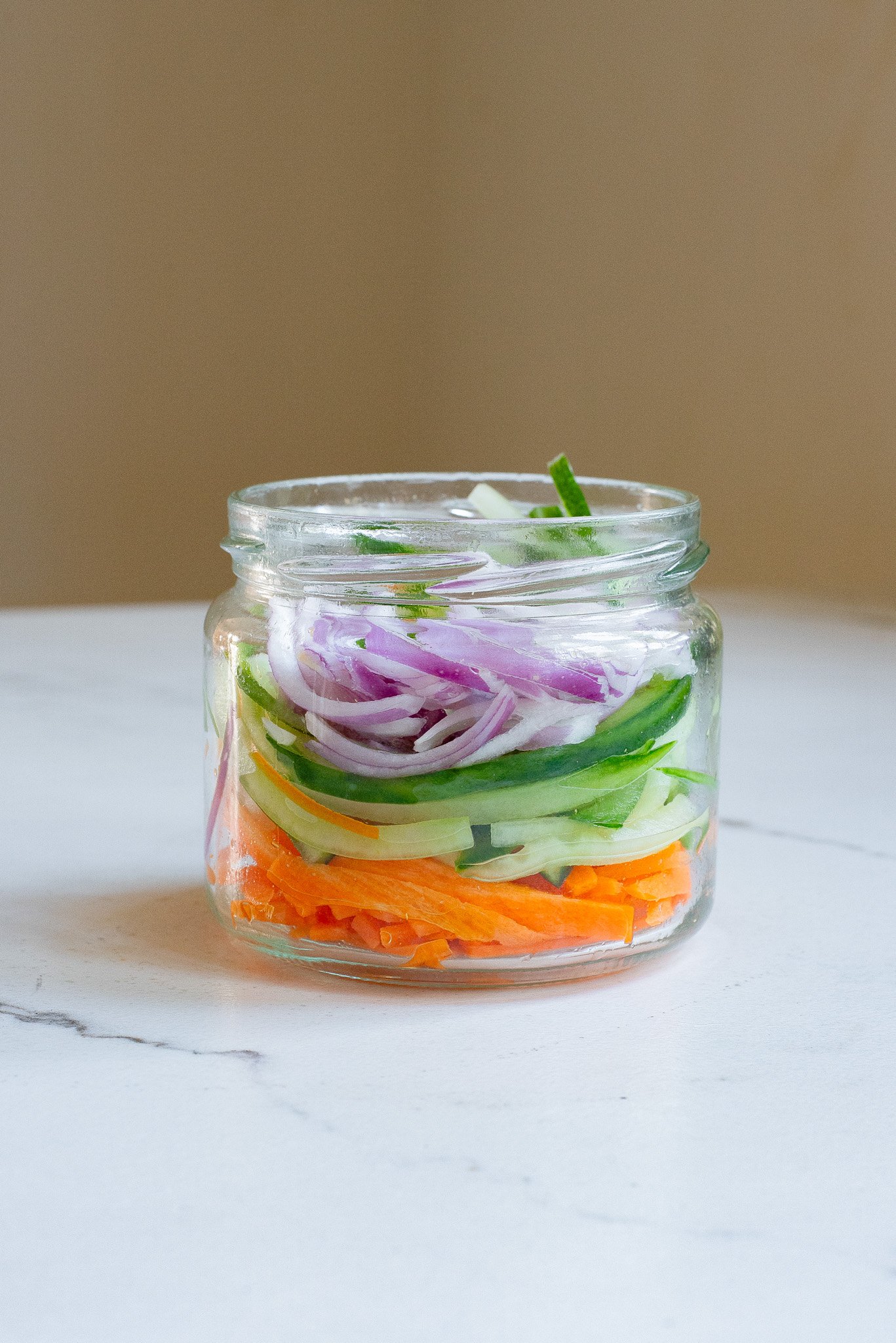
The Best Vegetables for Quick Pickling
One of the most exciting aspects of quick pickling is the sheer variety of vegetables you can use. Almost any vegetable can be transformed into a zesty delight! Here are some of the best and most popular options, along with tips for preparation:
- Cucumbers: The quintessential pickling vegetable! Crisp and refreshing, cucumbers are a classic choice for quick pickles. For best results, use pickling cucumbers or English cucumbers, sliced into rounds, spears, or even crinkle-cut chips. You can find a separate, dedicated dill pickle recipe here if you’re a purist!
- Radishes: These vibrant root vegetables add a beautiful pop of color and a peppery, zesty crunch to any dish. Slice them thinly for quick pickling; they are especially fantastic in Mexican and Southwest-inspired meals.
- Jalapeños: For those who love a spicy kick, pickled jalapeños are a must-try. Sliced into rings, they bring a pleasant heat and tangy flavor to tacos, burritos, rice bowls, and nachos. You can even mix them with other milder vegetables for a balanced heat.
- Bell Peppers: Sweet, colorful bell peppers (especially red, yellow, or orange) become wonderfully tangy when pickled. Slice them into strips or rings, and enjoy them in sandwiches, wraps, salads, or as a vibrant garnish. Pickled red bell pepper strips are particularly attractive and flavorful.
- Beets: Earthy and sweet, pickled beets offer a delightful sweet and tangy flavor profile. Roast or boil them until tender, then slice or cube them before pickling. They are excellent in salads, as a side dish, or simply enjoyed on their own.
- Zucchini and Summer Squash: When sliced thinly into rounds or ribbons, zucchini and various summer squashes can be quickly pickled for a light, refreshing side dish or a unique sandwich topping. They absorb the brine beautifully.
- Okra: A Southern delicacy, pickled okra is known for its crisp texture and distinctive tangy flavor. Pickling also helps to mitigate its sometimes-slimy texture. Enjoy them straight from the jar or as part of a relish tray.
- Turnips: Often seen in Mediterranean and Middle Eastern cuisines, pickled turnips have a sharp, tangy bite that pairs wonderfully with rich flavors. Slice them into wedges or sticks, then serve in hummus bowls, alongside falafel, or in wraps and salads.
- Carrots: As featured in this recipe, carrots become sweet, tangy, and slightly softened yet still firm when pickled. Julienned or sliced into rounds, they are incredibly versatile.
- Green Beans: Dilly beans are a classic for a reason! Crisp green beans pickled with dill and garlic are a fantastic snack or side dish.
- Cauliflower: Small florets of cauliflower offer a delightful crunch and absorb the pickling liquid well, making for a unique and savory pickle.
- Red Cabbage: Finely shredded red cabbage takes on a vibrant pink hue and a wonderfully crisp, tangy flavor when quickly pickled, perfect for topping tacos or pulled pork sandwiches.
- Asparagus: Blanched and then quick-pickled, asparagus spears make an elegant and flavorful addition to antipasto platters or salads.
When selecting vegetables, choose fresh, firm produce without blemishes. Cut them into uniform pieces so they pickle evenly. Thin slices or julienned strips generally absorb the brine faster and are ready to eat sooner.
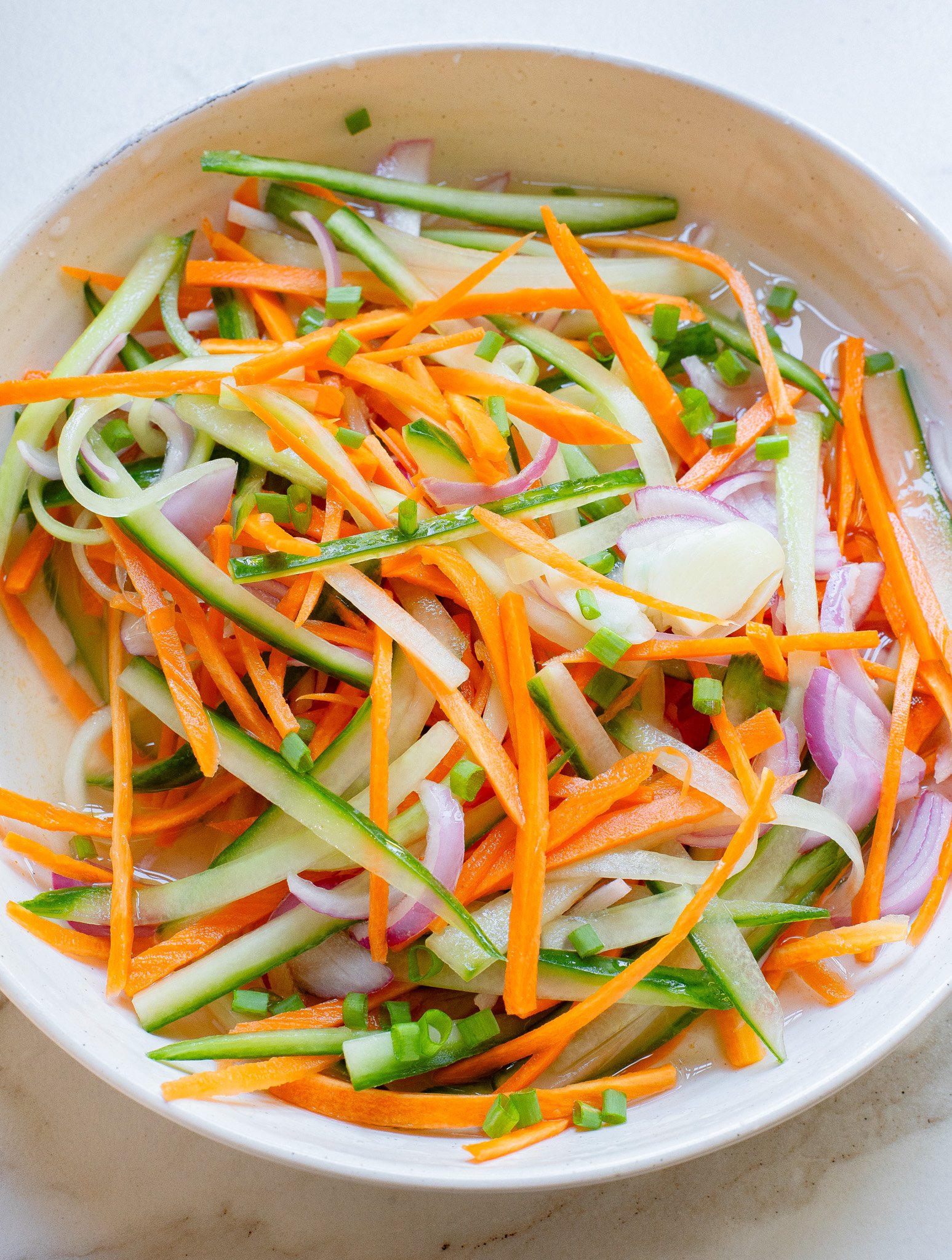
Serving Suggestions: How to Enjoy Your Quick Pickled Veggies
Once you’ve made a batch of quick pickled vegetables, you’ll find endless ways to incorporate their tangy flavor and satisfying crunch into your meals. Here are some of our favorite serving ideas:
- As a Side Dish or Snack: Enjoy them straight out of the jar! They make a refreshing and healthy snack, especially on a hot day.
- Enhance Salads: Toss quick pickled vegetables into any green salad, grain bowl, or pasta salad for an instant burst of flavor and texture.
- Elevate Sandwiches and Wraps: Layer them into your favorite deli sandwiches, grilled cheeses, or wraps. They cut through richness and add a delightful acidity.
- Top Tacos, Burritos, and Nachos: Pickled red onions, jalapeños, or carrots are absolutely fantastic on tacos, burritos, quesadillas, and nachos. Their tanginess complements spicy and savory fillings perfectly.
- Garnish Grain Bowls and Stir-Fries: Add a colorful and zesty topping to any grain bowl (quinoa, rice, farro) or stir-fry.
- Charcuterie and Cheese Boards: They are a vibrant and flavorful addition to any antipasto platter or charcuterie board, pairing wonderfully with cheeses, cured meats, and crackers.
- Alongside Grilled Meats: The acidity of pickled vegetables cuts through the richness of grilled chicken, pork, or beef, making them a perfect accompaniment.
- In Dressings and Sauces: Finely chop your pickled veggies and mix them into mayonnaise, yogurt, or sour cream for a quick, tangy sauce or dressing.
Storage and Longevity Tips
Proper storage is key to enjoying your quick pickled vegetables at their best and ensuring they remain safe to eat. Since these are refrigerator pickles and not traditionally canned, their shelf life is limited but still quite generous:
- Always Refrigerate: As the name “refrigerator pickles” suggests, these must always be stored in the refrigerator. The cold temperature slows down bacterial growth, while the acidic brine preserves the vegetables.
- Airtight Container: Store your quick pickled vegetables in a clean, airtight glass jar (like a mason jar) with a tight-fitting lid. This helps maintain freshness and prevents odors from seeping into or out of your fridge.
- Optimal Freshness: For the best taste and crisp texture, consume your quick pickled vegetables within up to 2 weeks. While they might technically be safe for a bit longer, their quality will start to decline, and they may lose their desired crunch and vibrant flavor.
- No Long-Term Canning: It’s crucial to reiterate: these are not meant for long-term, shelf-stable storage outside the refrigerator. The quick pickling method does not create the sterile, anaerobic environment required for pantry storage. Always keep them chilled!
- Signs of Spoilage: If you notice any signs of mold, an off-smell, or unusual cloudiness in the brine, it’s best to discard the batch immediately.
More Delicious Vegetable Recipes You’ll Love
Sides
Easy Bok Choy Recipe
Vegetarian
Instant Pot Lebanese Green Beans
Vegetarian
Balsamic Roasted Carrots
Vegetarian
Za’atar Roasted Carrots
Tried this recipe? Leave a star rating and comment below! Subscribe to my newsletter or follow me on
Facebook,
Instagram, or
Pinterest for the latest.
Quick Pickled Vegetables
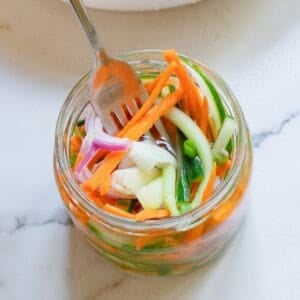
Saved
Pin
Ingredients
- 1 small carrot, peeled, cut in julienne
- 1/3 English cucumber, cut in julienne
- 1 medium red onion, sliced thinly
- 1 cup white vinegar
- 1/2 cup water
- 1 tablespoon white sugar
- 4 cloves garlic , crushed
- 1/2 teaspoon sea salt
- 2 teaspoon whole peppercorns, optional
- 1 tablespoon coriander seeds, optional
- 2 teaspoon mustard seeds, optional
- fresh dill, optional
- Pinch crushed red pepper flakes, optional
- 1 tablespoon green onion, chopped
Instructions
-
Prepare a clean, sterilized mason jar for the vegetables.
-
Add the prepared carrot, cucumber, and red onion to the mason jar, packing them in snugly.
-
In a saucepan, bring the vinegar, water, sugar, crushed garlic, and salt to a boil. Stir until sugar and salt are completely dissolved. Remove from heat and let it cool until slightly warm. Pour the liquid mixture over the vegetables in the mason jar.
-
Add the whole peppercorns, coriander seeds, and mustard seeds to the jar.
-
Tuck in a few sprigs of fresh dill (or other preferred herbs like parsley or oregano), a pinch of crushed red pepper flakes (if using), and the chopped green onion. Ensure all vegetables are submerged and leave about a half-inch of headspace. Let cool to room temperature for two hours, then seal the mason jar tightly and give it a gentle shake.
-
Refrigerate the pickled veggies for at least 10 hours before enjoying them. This allows them to fully pickle and soak in all the wonderful flavors.
-
Store your quick pickled vegetables in the refrigerator for up to 2 weeks. Remember, these are not canned for long-term, pantry storage; they MUST be kept refrigerated.
Notes
- You will want to make sure the liquid covers all of the vegetables but also leave about a half-inch of room from the top of the jar/lid. This headspace is important for proper sealing and to prevent overflow.
- Feel free to use whatever veggies you have on hand – this recipe is highly adaptable! Just make sure to cut them to the appropriate size and shape to fit your mason jar and ensure even pickling.
- Please remember these are not canned for long-term storage – they should always be kept refrigerated for safety and best quality.
Nutrition
Nutrition information is automatically calculated, so should only be used as an approximation.
